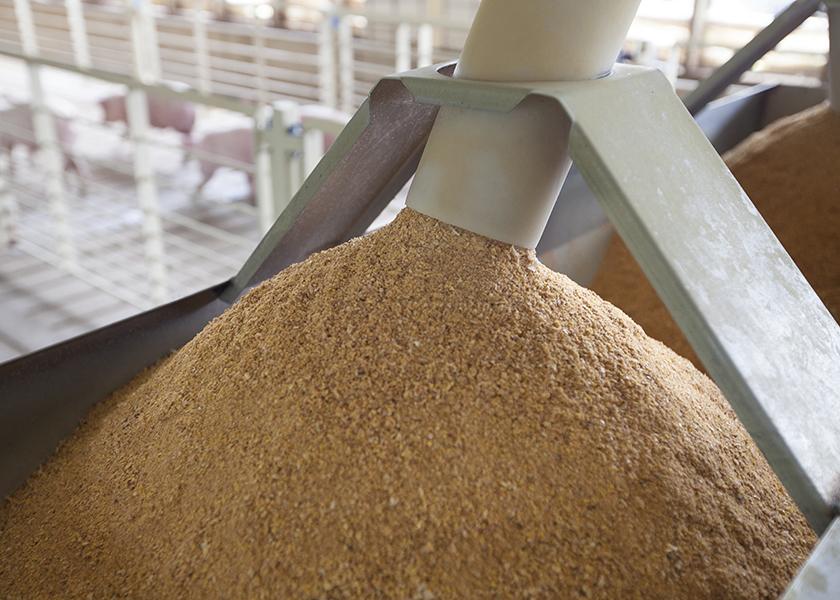How Should the Animal Feed Industry Value Soy Protein?

When it comes to livestock diets, soy is traditionally evaluated on one metric: crude protein. However, recent research shows that crude protein is not the best indicator for meeting the nutritional needs of livestock. The U.S. Soybean Export Council (USSEC) shared why soybeans aren’t all created equal and how buyers can discern how those differences impact profitability during the Commodity Classic on March 3.
Is U.S. Soy Really Better?
2020 data revealed that U.S. soy was lower in crude protein content compared to 2019, said Maria Mayorga, a livestock nutritionist and a USSEC regional poultry technical expert. So, USSEC took a deeper look into the differences.
“We saw actually that we were providing 12 more kCals of net energy for grower pigs and sows, which is pretty interesting, because we found out that the composition between the soybean meals from the U.S. in 2020 and 2019 were different,” Mayorga said. “In 2020, we got more total sugars and more starch, which are readily available energy sources. Also, we got more sucrose in 2020 compared to 2019.”
Despite the decrease in crude protein U.S. soy saw in 2020, U.S. soy was providing more energy and more amino acids for the animal to grow efficiently, Mayorga said.
In addition to evaluating processing indicators, USSEC evaluated soy from different origins and saw a similar trend. U.S. soy had a lower crude protein content than competitors Brazil and Bolivia. But Mayorga noted U.S. soy had a higher content of sugars than Brazil and Bolivia and similar content to Argentina.
“We also analyzed the amino acid profile of different origins and found that we get advantages compared to Argentina and Bolivia. Sometimes this profile is highly dynamic and sometimes we get advantages over other origins. Depending on the time of the year and the season, we are able to detect those differences regarding relative abundance of amino acids,” Mayorga said. “However, if we analyze the digestibility, which represented what is really available for the animals to grow, and to absorb efficiently, we can see that U.S. soy exhibited higher levels of digestibility regarding essential and non-essential amino acids.”
She noted the research shows U.S. soy provides more kCals per kilo of soybean meal than Argentina, Brazil and Bolivia.
“That's very interesting, because regardless of protein content, we are providing more energy for the animals to grow and to maintain vital functions,” Mayorga said. “Remember, energy cannot be manufactured, so we have to provide that through the diet.”
Show Me the Money
Although this may sound appealing, people are more interested in how it pencils out financially, said Jim Sutter, USSEC CEO.
“People want to know, ‘What are the economics of all this? Sure, you've told me there are more kCals or there's more lysine, but how do you turn that into dollars and cents? And what does it mean for someone who is raising chickens or pigs somewhere around the world and is deciding which type of soybean meal to use?’” Sutter said.
A new tool created by Genesis Feed Technologies, in collaboration with USSEC, will help people answer that question, he said.
“It's a very elaborate tool that does feed formulation and allows whoever the feeder is, the person producing the feed or feeding the livestock, to put their own formulation parameters in,” Sutter said. “They can put in their own data about the quality of the product and their own pricing information in, but then it gives them a financial result for the dollars-and-cents impact of using one origin of soy versus another origin of soy.”
In essence, the nutrient value calculator demonstrates the value of U.S. soy products in practical diets.
“With these very high commodity prices, people are looking for alternative ingredients,” said Matthew Clark of Genesis Feed Technologies. “We all say the alternative ingredient is a better soybean meal, that's the best one to go for to find the money.”
Clark said the nutrient value calculator gives commercial people a vision into the formulation process to make commercial decisions. This platform expresses the technical side of soybeans in a very commercial language, so people can see what nutrients and characteristics will make a difference to the profitability of the companies.
“Like my grandchildren, the soybean is small and complicated when we look at what's inside a soybean,” Clark said. “Over the years we've thought of soybeans as a protein source and an oil source. But it's more than that.”
He stressed the importance of amino acid digestibility and pointed out the higher level of sucrose in U.S. soy than most other destinations.
“Our challenge is to look at the full profile of the soybean meal, take account of every single component and turn those technical details into a profit figure,” Clark said.
Through a commercial formulation system, the nutrient value calculator can show the profit-and-loss situation so buyers can see where money is being made by making a particular choice.
“The nutrient value calculator is exciting because it uses the full nutrient profile evaluation,” Clark said. “Every little detail that goes into a soybean in America is captured in this tool for promotional purposes. The way it works, we look for the lowest cost of goods in the feed mill, we are helping our customer seek profits. We are really thrilled to be working with the USSEC team on a global basis to show off how we can generate and understand the value of a better soybean meal.”
More from Farm Journal's PORK:
China is Just Part of the Demand Story Sparking a Surge in Pork Prices







